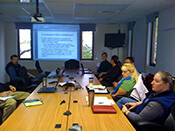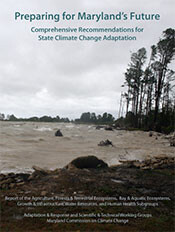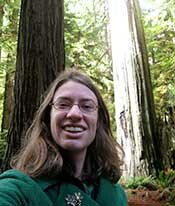Engaging the public to help preserve the unique natural and cultural resources of two National Parks in Hawaii
 Following up from an August visit and series of on-site workshops run by IAN staff Tim Carruthers and Jane Hawkey, three science communication products have just been published for two Hawaiian parks in the National Park Service's (NPS) Pacific Island Network. For Hawai'i Volcanoes National Park (HAVO) on the big island of Hawai'i, two flyers target resident or off-island audiences in an effort to enlist their help in preventing the spread of invasive plants and animals, especially in areas yet to be overrun by these alien species. For Kalaupapa National Historical Park (KALA) on the island of Molokai, a poster designed for resident and off-island audiences features both the cultural and natural history of this remote peninsula, and highlights the unique native plants and animals found here that are currently challenged by invasive species, overfishing, pollution, and climate change.
Following up from an August visit and series of on-site workshops run by IAN staff Tim Carruthers and Jane Hawkey, three science communication products have just been published for two Hawaiian parks in the National Park Service's (NPS) Pacific Island Network. For Hawai'i Volcanoes National Park (HAVO) on the big island of Hawai'i, two flyers target resident or off-island audiences in an effort to enlist their help in preventing the spread of invasive plants and animals, especially in areas yet to be overrun by these alien species. For Kalaupapa National Historical Park (KALA) on the island of Molokai, a poster designed for resident and off-island audiences features both the cultural and natural history of this remote peninsula, and highlights the unique native plants and animals found here that are currently challenged by invasive species, overfishing, pollution, and climate change.
New partnership to standardize indicators and methods in Chesapeake Bay
 EcoCheck initiated a new effort to develop standards for data collection and analysis by watershed organizations and tidal volunteer monitoring networks. Participants include representatives from the Nanticoke, Choptank, Chester, Sassafras, Magothy, Severn, South, West/Rhode, and St. Mary's Rivers, with additional members expected to join. Currently, each organization collects and reports data for different indicators and in different ways, making comparison between datasets difficult. This new effort tasks the group with identifying a core set of indicators that should be collected, developing standard sampling and analysis methods for those indicators, and establishing common considerations for designing sampling schemes. Guidelines will be produced for other non-profit or volunteer-based groups assessing ecosystem health, and will hopefully lead to a rich and robust data set that can help fill a critical data gap in Bay tributaries.
EcoCheck initiated a new effort to develop standards for data collection and analysis by watershed organizations and tidal volunteer monitoring networks. Participants include representatives from the Nanticoke, Choptank, Chester, Sassafras, Magothy, Severn, South, West/Rhode, and St. Mary's Rivers, with additional members expected to join. Currently, each organization collects and reports data for different indicators and in different ways, making comparison between datasets difficult. This new effort tasks the group with identifying a core set of indicators that should be collected, developing standard sampling and analysis methods for those indicators, and establishing common considerations for designing sampling schemes. Guidelines will be produced for other non-profit or volunteer-based groups assessing ecosystem health, and will hopefully lead to a rich and robust data set that can help fill a critical data gap in Bay tributaries.
IAN hosts climate change workshops
 Maryland is a national leader in planning for climate change, and IAN is helping the adaptation planning effort. The Adaptation & Response and Scientific & Technical Working Groups of the Maryland Commission on Climate Change have been charged with taking state adaptation planning beyond coastal vulnerability (addressed in the Climate Action Plan in 2008). Kate Boicourt (UMCES) and Zoe Johnson (DNR) have been looking at impacts, strategy, and information gaps by establishing six sector-based subgroups: agriculture, water resources, bay & aquatic ecosystems, forests & terrestrial ecosystems, human health, and growth & infrastructure. Bill Dennison and Dave Nemazie have facilitated the first meetings. Common themes have been maintaining connections between sectors, managing for flexibility in the face of uncertainty, invasive species and pests, and concern about the capacity of current and future infrastructure to handle rapid change. Groups will meet again in the new year to hone the first comprehensive adaptation recommendations.
Maryland is a national leader in planning for climate change, and IAN is helping the adaptation planning effort. The Adaptation & Response and Scientific & Technical Working Groups of the Maryland Commission on Climate Change have been charged with taking state adaptation planning beyond coastal vulnerability (addressed in the Climate Action Plan in 2008). Kate Boicourt (UMCES) and Zoe Johnson (DNR) have been looking at impacts, strategy, and information gaps by establishing six sector-based subgroups: agriculture, water resources, bay & aquatic ecosystems, forests & terrestrial ecosystems, human health, and growth & infrastructure. Bill Dennison and Dave Nemazie have facilitated the first meetings. Common themes have been maintaining connections between sectors, managing for flexibility in the face of uncertainty, invasive species and pests, and concern about the capacity of current and future infrastructure to handle rapid change. Groups will meet again in the new year to hone the first comprehensive adaptation recommendations.
New IAN Intern - Kate Bentsen
 Kate started work at IAN this December as a Science Communication Intern, in her home state of Maryland. She graduated this May from Cornell University with a degree in Natural Resources, and spent the past five months in Washington State surveying streams in the Puget Sound. Past work experience has found her scattered across the country, working in stream systems of Montana and Idaho, the desert of New Mexico, and with salamanders in forest systems of upstate New York. When not in the field for work, Kate enjoys hiking, backpacking, reading, sending mail, and cooking.
Kate started work at IAN this December as a Science Communication Intern, in her home state of Maryland. She graduated this May from Cornell University with a degree in Natural Resources, and spent the past five months in Washington State surveying streams in the Puget Sound. Past work experience has found her scattered across the country, working in stream systems of Montana and Idaho, the desert of New Mexico, and with salamanders in forest systems of upstate New York. When not in the field for work, Kate enjoys hiking, backpacking, reading, sending mail, and cooking.